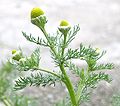bio.wikisort.org - Plant
Matricaria discoidea, commonly known as pineappleweed,[3] wild chamomile, disc mayweed, and rayless mayweed, is an annual plant native to northeast Asia where it grows as a common herb of fields, gardens, and roadsides.[4] It is in the family Asteraceae. The flowers exude a chamomile/pineapple aroma when crushed. They are edible and have been used in salads (although they may become bitter by the time the plant blooms) and to make herbal tea. Pineappleweed has been used for medicinal purposes, including for relief of gastrointestinal upset, infected sores, fevers, and postpartum anemia.
| Matricaria discoidea | |
|---|---|
 | |
| Pineappleweed | |
| Scientific classification | |
| Kingdom: | Plantae |
| Clade: | Tracheophytes |
| Clade: | Angiosperms |
| Clade: | Eudicots |
| Clade: | Asterids |
| Order: | Asterales |
| Family: | Asteraceae |
| Genus: | Matricaria |
| Species: | M. discoidea |
| Binomial name | |
| Matricaria discoidea DC. | |
| Synonyms | |
|
Artemisia matricarioides auct. | |
Description
The flower head is cone-shaped, composed of densely packed yellowish-green corollas, and lacking ray-florets. The leaves are pinnately dissected and sweet-scented when crushed. The plant grows 2 to 16 in (5.1 to 40.6 cm) high. Flowerheads are produced from March to September.
Distribution
The plant grows well in disturbed areas, especially those with poor, compacted soil. It can be seen blooming on footpaths, roadsides, and similar places in spring and early summer. In North America, it can be found from central Alaska down to California and all the way to Nova Scotia and Newfoundland. It has also become common and naturalized in Britain.[5]
- Native
- Palearctic
- Russian Far East: Amur Oblast, Kamchatka Peninsula, Khabarovsk Krai, Kuril Islands, Magadan Oblast, Primorsky Krai, Sakhalin
- Eastern Asia: Hokkaido
Uses
The greens can be washed and eaten, and both the flowers and the whole plant can be steeped to make tea,[6] described as excellent by one field guide.[7]
Gallery
- The pinnately dissected leaves are sweet-scented when crushed
References
- USDA, NRCS (n.d.). "Matricaria discoidea". The PLANTS Database (plants.usda.gov). Greensboro, North Carolina: National Plant Data Team. Retrieved 2008-06-14.
- Germplasm Resources Information Network (GRIN) (2005-09-07). "Taxon: Matricaria discoidea DC". Taxonomy for Plants. USDA, ARS, National Genetic Resources Program, National Germplasm Resources Laboratory, Beltsville, Maryland. Archived from the original on 2008-04-22. Retrieved 2008-06-14.
- BSBI List 2007 (xls). Botanical Society of Britain and Ireland. Archived from the original (xls) on 2015-06-26. Retrieved 2014-10-17.
- "Pineapple Mayweed". NatureGate.
- The Wildlife Trusts, "Pineappleweed" http://www.wildlifetrusts.org/species/pineappleweed
- Nyerges, Christopher (2017). Foraging Washington: Finding, Identifying, and Preparing Edible Wild Foods. Guilford, CT: Falcon Guides. ISBN 978-1-4930-2534-3. OCLC 965922681.
- Benoliel, Doug (2011). Northwest Foraging: The Classic Guide to Edible Plants of the Pacific Northwest (Rev. and updated ed.). Seattle, WA: Skipstone. p. 123. ISBN 978-1-59485-366-1. OCLC 668195076.
External links
- USDA Plants Profile for Matricaria discoidea (Disc mayweed, Pineapple weed)
- Jepson Manual treatment: for Chamomilla suaveolens —Matricaria discoidea
- University of Michigan Native American Ethnobotany — Matricaria discoidea
- Pineapple weed - Matricaria discoidea
- Robbins, W. W., Margaret K. Bellue, and Walter S. Ball. 1970. Weeds of California. Documents and Publications, Sacramento. 547 p.
- Gregory L. Tilford. 1997. Edible and Medicinal Plants of the West. Mountain Press Publishing Company, Missoula. 110 p.
- University of California-Davis, Statewide Integrated Pest Management Program — 'Pineapple weed'
- Den virtuella floran: Matricaria discoidea distribution
- Matricaria discoidea — U.C. CalPhotos Gallery
На других языках
- [en] Matricaria discoidea
[es] Matricaria discoidea
Matricaria discoidea es una planta de la familia de las compuestas.[ru] Ромашка пахучая
Рома́шка паху́чая, или Ромашка безъязычко́вая, или Ромашка зелёная, или Ромашка души́стая, или Ромашка ромашкови́дная, или Лепидотека паху́чая (лат. Matricária discoídea) — травянистое растение; вид рода Ромашка семейства Астровые, или Сложноцветные.Другой контент может иметь иную лицензию. Перед использованием материалов сайта WikiSort.org внимательно изучите правила лицензирования конкретных элементов наполнения сайта.
WikiSort.org - проект по пересортировке и дополнению контента Википедии




